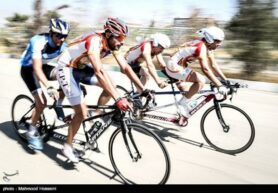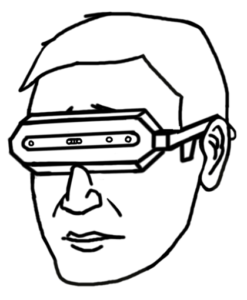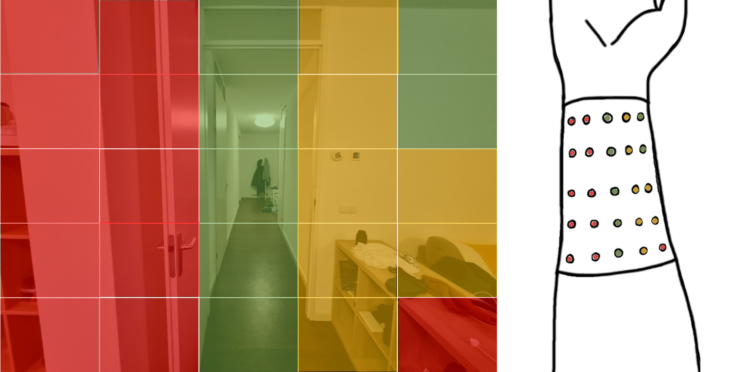(Dis)Abilities in Sports
Overcoming Obstacles: Blind Assistive Technology in Sports
by Jamie Campos, April 13 2022
A pair of skiers glide down a hill, the guide in the lead looks intently at his partner, assessing her condition. As the hill rounds out, they continue to ski in formation and the guide barks an order, “Right!” As they come to the bottom of the 12.5km course, the one following assumes a prone position at her designated spot and, heart pumping, puts on her headphones and takes up the rifle. 10 meters away, 5 circles just 2 centimeters across light up one by one accompanied by the clicks of the laser rifles—finishing at just over 50 minutes, Oksana Shyshkova, a visually impaired athlete, has completed her gold medal run at the 2022 Winter Paralympics biathlon event.
The loss of vision would have an unimaginable effect on anyone’s daily life. From the outside, the significantly visually impaired competing in sports seems impossible. Yet with a bit of teamwork and clever engineering visually impaired athletes compete regularly at sports. However, as technology evolves, how will assistive technology improve, and what might that mean for visually impaired athletes?
Before we look to the future, a quick overview of what we have today:

1998 National Para-cycling Championship, Iran
On the less technological side, many visually impaired athletes make use of a guide who competes along with them, giving commands verbally and leading them through the course. Guides are used in many course-based sports including the biathlon where they ski ahead of the athlete and cycling where the guide and athlete bike in tandem. The guide-athlete pairing is founded on trust, and they are often regarded as a team.
On the opposite side of the spectrum, in visually impaired rifle-based sports like the biathlon, an aiming device is attached to the rifle that detects the rifle’s point of aim in relation to the target. Based on how far off the mark the rifle is pointing, a tone is generated, a higher pitch being closer to bullseye. This allows the athletes to aim completely without the use of their eyes.
Visually impaired sports where assistive technology is used are the exception, most sports opting for a low-tech manual guide. Obstacle detection technology is currently found in most recent consumer vehicles, the most common kind being some sort of audio cue when the user backs up that often beeps faster when they’re closer to an obstacle. In January of this year, two students from the Technical University of Munich developed a system that makes this technology wearable and may, someday, replace guides in their entirety.

Artist’s rendition of the camera mounted glasses. Illustration by Sheel Thadhani
The system involves an infrared-based 3D camera mounted to a pair of glasses that detects where nearby obstacles are. The system then relays the information using a specially made feedback sleeve. What makes the sleeves special is a grid of small vibrating motors, 5 motors tall and 5 motors wide, that will vibrate to relay how close an obstacle is to the user.

Artist’s depiction of how information is relayed using the sleeve. To the left is an image with the sensing grid overlayed and to the right the vibrating sleeve. Red indicates a close by obstacle, yellow a medium distance obstacle, and green no immediate obstacle. Illustration by Sheel Thadhani
To test the glasses, the developers put volunteers in a darkened set of rooms and timed how long it would take for them to navigate the course. Each volunteer completed the route once a week over three weeks. It was found that, on average, the time it took users to navigate the course decreased by over half, with some users cutting their times down to just a fourth of their original time. This indicates that the system is easily adoptable by new users and may get even easier to use over time.
This initial version is unfortunately unsuited to use in sports for a variety of reasons. To begin with, when following a route, it may be difficult to tell where to turn due to the lack of guiding obstacles on most routes as they take place in relatively open areas. This could be addressed by using safety barriers giving the athletes a softened landing in an emergency and giving the system guiding walls to follow. Additionally, the glasses were only able to relay the information every 6th of a second, a delay that could be dangerous at high speeds. However, with some development time, the processing time may go down to something that is usable at higher speeds.
The greatest risk in the adoption of technology for visually impaired sports is the chance that the technology will, in some way, fail. This chance is a major reason that technological solutions are often not applied in high-risk situations; and if they are, they are backed by low tech failsafes. For example, in household electronics most devices have parts that will regulate the amount of power they use and shutdown if they detect any unexpected changes. However, this is always backed by the relatively low-tech fuse which physically burns out and disconnects the electricity to a device.
Due to the risks involved and additional development needed to make the system detect obstacles at a more useful speed, it’s unfortunately unlikely that this will be available as a consumer product in the near future. While the solution of the future may not be this specific system, this is reassurance that research is certainly ongoing to enable visually impaired people to engage with the world as they see fit.
Sources
Flanagan, S. M. (2018, February 22). Being a Sighted Guide. Burnaby; BC Blind Sports.
Hosseini, M. (1998). Paracycling League 2. Tasnim News. photograph, Tasnim News. Retrieved March 18, 2022, from https://www.tasnimnews.com/fa/media/1398/06/14/2091141/%d9%85%d8%b3%d8%a7%d8%a8%d9%82%d8%a7%d8%aa-%d8%af%d9%88%da%86%d8%b1%d8%ae%d9%87-%d8%b3%d9%88%d8%a7%d8%b1%db%8c-%d9%be%d8%a7%d8%b1%d8%a7%d8%b3%d8%a7%db%8c%da%a9%d9%84%db%8c%d9%86%da%af-%d9%82%d9%87%d8%b1%d9%85%d8%a7%d9%86%db%8c-%da%a9%d8%b4%d9%88%d8%b1#photo=18.
Paralympic Games. (n.d.). How To: Para-Biathlon – visual impairment category. YouTube. Retrieved April 6, 2022, from https://www.youtube.com/embed/J1nUgYkhyrE.
Sport week: 10 things to know about para biathlon. International Paralympic Committee. (2022, February 3). Retrieved March 16, 2022, from https://www.paralympic.org/feature/sport-week-10-things-know-about-para-biathlon
Target shooting. British Blind Sport. (2021, August 3). Retrieved March 16, 2022, from https://britishblindsport.org.uk/membership/bbs-sports/target-shooting/
Thadhani, S. F. (n.d.). Man wearing 3D IR goggles.
Thadhani, S. F. (n.d.). Arm wearing haptic feedback sleeve.
Zahn, M., & Khan, A. A. (2022, January 12). Obstacle avoidance for blind people using a 3D camera and a haptic feedback sleeve (thesis). Retrieved March 18, 2022, from https://arxiv.org/abs/2201.04453.

